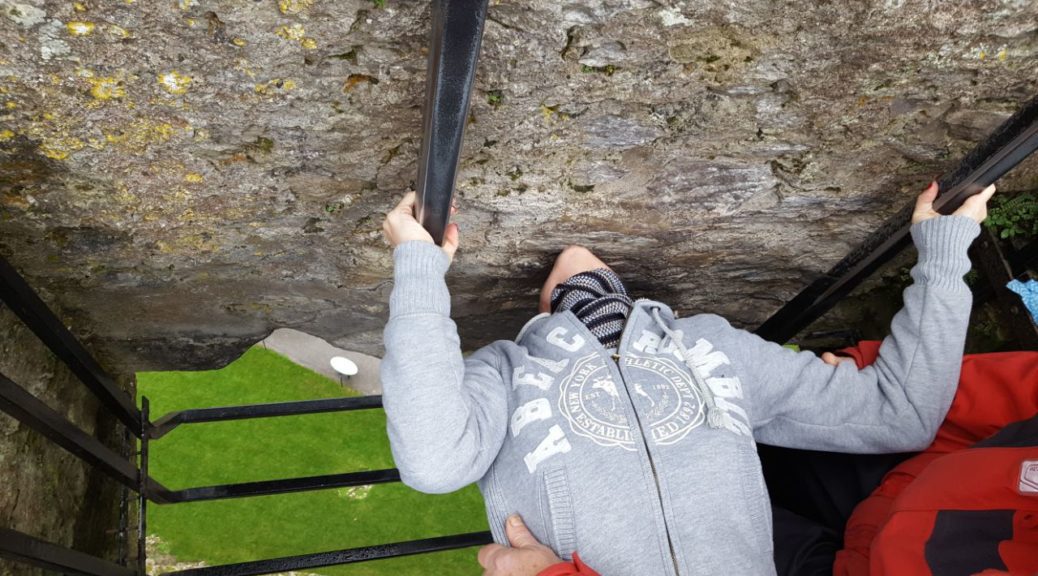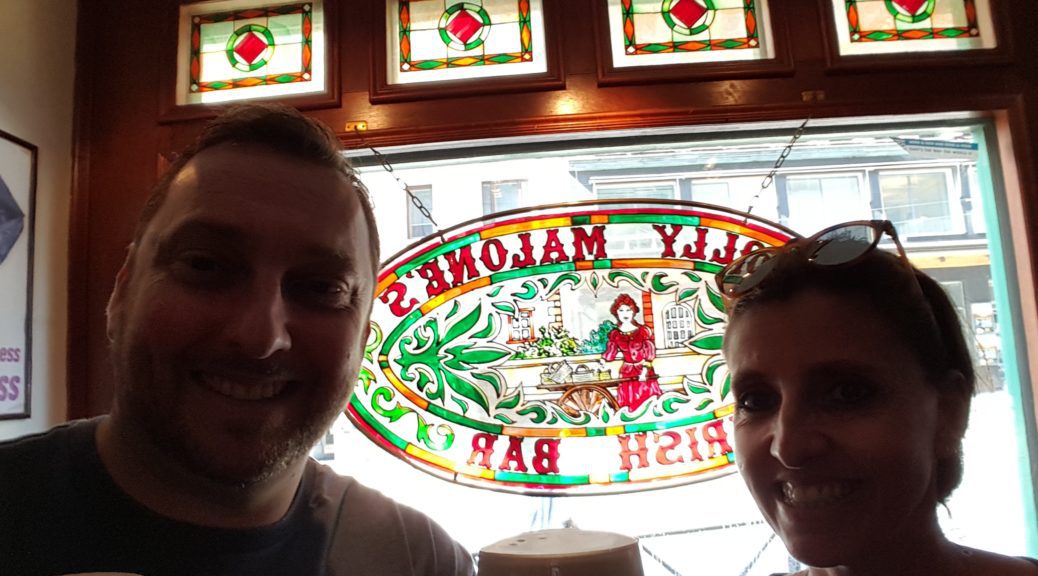CORK
19-20 November 2017
We had 132km to travel from Waterford to our stop for the night, Cork, which we planned to break with a quick visit to the Midleton / Jameson distillery en route.
Again it was all double lane highway so an easy drive, which was fortunate since our “break” at Midleton turned out to only be a hop, skip and a jump (24km) from our final destination.
Our arrival was ill-timed, with a tour having just departed so, not prepared to wait almost an hour for the next one, we made do with our own makeshift tour of the giftshop and all the exhibits in the reception area. Suited me fine since, seeing as I’m convinced I’m allergic to whiskey since it has made me violently ill both times I’ve tried it (in my twenties), this excursion has been filling me with trepidation since Christian suggested it!
He was also filled with less anxiety pulling out of the distillery having literally rather than figuratively ‘bought the t-shirt’ – a relief we both expressed when less than half an hour later we were negotiating the lanes around our residence, so tight that I actually got out of the car to direct as we inched through!
We had booked into a hostel in Cork, which we do by rare exception and had only done so this time since they offered private en suite rooms. Turns out that there were only a handful, enabled by the hostel having bought the townhouse next door. It felt like we had an apartment since we had a suite that opened onto a twin bedroom, with a private double bedroom on the one side and bathroom on the other. It was flippen’ freezing in the room, so the extra duvets would come in handy!
Having not eaten since breakfast and no doubt psyched by the fact that it was dark even though it was only 16h00, the first and only priority was to get some dinner.
Our burly but friendly reception desk chap hadn’t hesitated an instant when we asked for a referral, offering The Fish Wife as his recommendation. Perfect. He’d given us a very simple tourist map and set us on the right direction so we headed off into the night (well, dark afternoon), single-minded.
The fish ‘n chips shop was tiny, with a couple of bar stools in the small customer-side of the mostly-kitchen space. But it smelled heavenly and offered the service of delivering your food to you across the road on the ‘heated & seated’ terrace of the Shelbourne pub, should you be amenable to returning the favour and buying a drink.
We were amenable and ordered a Murphy’s stout (checking out the competition, being on their home turf ‘n all) while we waited, people-watching the bustling MacCurtain Street in rush hour.
Soon our cod and chips (with mushy peas) arrived and we could see what all the fuss was about. It wasn’t as homely as North Shields Fish Quay (in Newcastle Upon Tyne) with their complimentary bread & butter and pots of tea, nor as picturesque as Mersea Island‘s offering, but it was generously portioned, delicious and well-timed which is a hattrick that adds big points.
Fed and happy we followed the sounds of cheering that we’d heard intermittently as the wind had carried it in our direction. Over the River Lee and into what looked to be Cork’s upmarket shopping hub. As we crossed over the bridge we could see that the street ahead that ran between the big glossy department stores lining either side had been cordoned off and we were faced with the back of a stage.
We followed the crowds around the block, eager to see what all the fuss was about. Turned out to be a big event celebrating turning on the town’s official Christmas lights. The road was packed and there were entertainers and food stalls keeping everyone in good humour and piped commentary from the local radio station, who seemed to be hosting the event. Nothing was happening on the stage yet, but there was obviously a show to follow.
We hung around for about half an hour, soaking up the vibe and the surrounds, but on asking a policeman what time things were happening and being told there was another hour and a half to wait, we decided that we’d seen enough Christmas lights in our time to imagine what takes ones would be like.
We made our way back to the entertainment district and picked Corner House pub to round off the day with Guinness (logged on our Guinness Index of course) and traditional music.
Having consulted THREE weather sites for a rain-check, I was confident it was Not Raining on Monday so, because it was warming up and dry, I ditched the full hooded waterproof jacket in favour of a more comfortable lined hoodie that would suit our ‘in and out the car’ day.
We headed off to Cobh (pronounced ‘cove’), the last stop of the ill-fated Titanic journey, as our first excursion for the day.
Needless to say the ‘not rain’ was still too much rain for us and we skipped the waterfront walk and museum visit we’d planned to enjoy a real genuine homegrown Cobh breakfast instead.
It was a great call – 3 pork sausages, bacon and an egg on a mammoth roll, washed down by a pot of tea, for €5 each, from a tearoom that had been exactly there for over 100 years, told us more about Cobh than we’d intended to learn. Double thumbs up!!
It was slightly less not-raining when we left the tearoom and we managed a quick trot along the promenade, which rewarded us with a photo opp with a passing Irish Battleship!
Feeling smug and rewarded for a great decision and job well done, we hit the road for Blarney.
30 something kilometres later we got to Blarney to visit the famous Blarney Castle and kiss the Blarney Stone.
The Castle is the 3rd structure to be on the site: a 10th Century wooden hunting lodge was replaced by a stone structure in around 1210, which was demolished and used as foundations by Cormac McCarthy in 1446. It’s the tower of this 3rd castle that tourists have been visiting for hundreds of years to see the Blarney Stone which is embedded in the walls below the battlements. Kissing the stone is supposed to give the ‘gift of the gab’ and, being slightly below floor level, requires that you lie on your back and bend over backwards to kiss it. It’s likely a load of baloney, but still worth a shot!
You can walk through the whole castle, exploring the alcoves and niches that branch from the central narrowing spiral stone stairwell. While an architectural and construction victory to be still standing all these years later, it was a far from comfortable dwelling style. And must have been a mission to furnish!
The castle was set in magnificent gardens, said to be one of the most visited in Ireland (hardly surprising with the Castle as a top attraction and with the price of the entry ticket!) so we took a wander around the prehistoric fern garden, the deadly Poison Garden and Rock Close with the Yew trees and Druid stones until it started to not-rain again so we headed for the car.
Leaving Blarney we had the end goal for the day in mind – get to Killarney.


